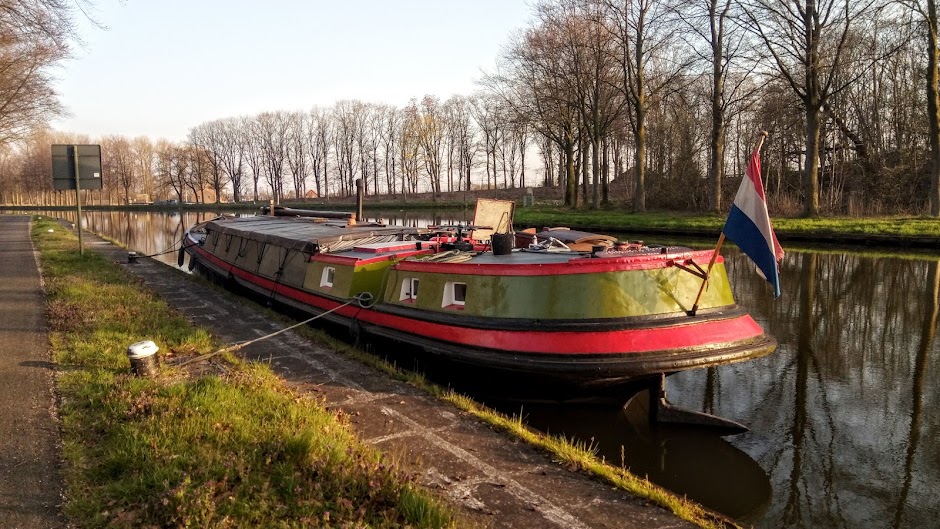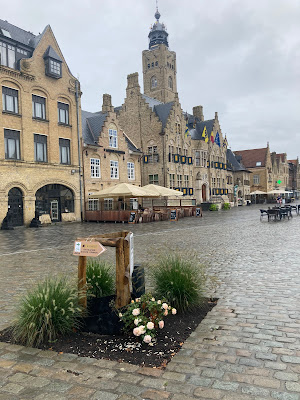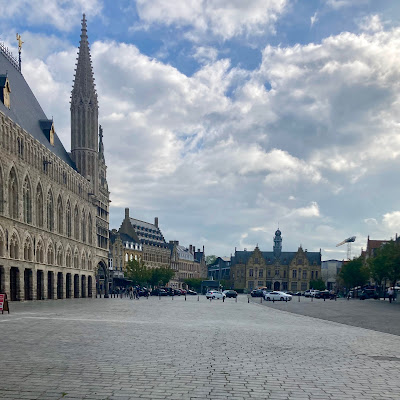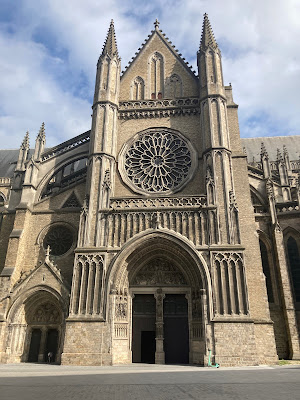 |
| Peter and Jo's wonderful cruiser. It's like a Mary Poppins bag: it looks small but is huge inside, with every home comfort you could wish for |
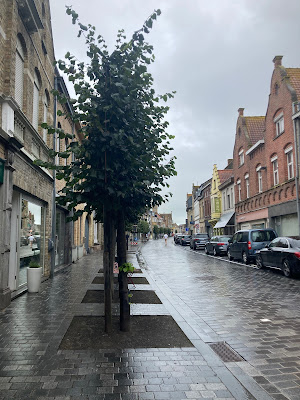 |
| The main shopping street leading to the city square |
 |
| This and the photos below are all different views of the square, which is normally busy with both locals and visitors on a summer's day |
 |
| The HH and the Frog that almost croaked when we arrived... |
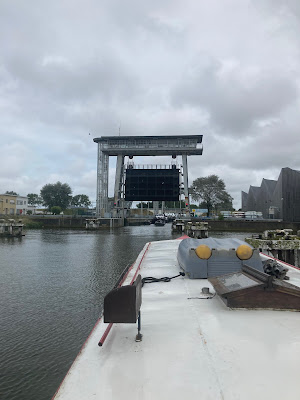 |
| If you enlarge the photo you'll see the sign |
 |
| The Hennie H just before the Rattervalle Bridge |
 |
| Sunset over Flanders |
 |
| Zoe needs no introduction |
We spent the next few days, retracing our route, but this time slowly. Not that we were hurrying before but Veurne was the only place we'd spent more than two nights. It was still very warm and we were glad to take it easy, as was Zoe.
 |
| It was much easier to keep her cool once she decided to go into her little dog house |
After visiting a longtime friend whose museum barge, Tordino, was moored just beyond the junction of the Bruges-Ostend Canal with the Plassendale canal, we spent two nights at our favourite nowhere mooring a few kilometres further on. The first night was at the pontoon on the south side of the canal, close to a level crossing. Koos spent some happy time filming trains, which are his other passion in life. I, in turn, had a wonderful walk in pastoral countryside with Zoe. For the second night, we crossed the canal to the pontoon where we'd stayed on route to Veurne. Because we could only spend 12 hours on each pontoon in any one day, this was a good solution, particularly as it meant discovering a farm which did particularly delicious ice-cream and cakes. Irresistible, as I'm sure you'll agree when you see the photo.
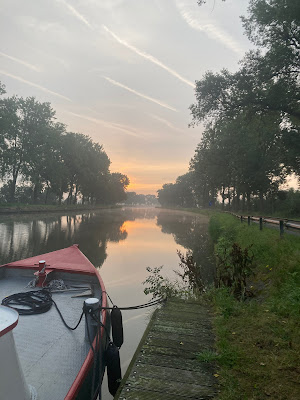 |
| Sunrise on the canal to Bruges |
 |
| A farm on my walk |
 |
| The farm from a different angle |
 |
| I don't know if you can see them but I was captivated by the swallows swooping above me on the road. |
 |
| A luscious ice-cream treat for Koos and apple cake for me. Coffee comes with small cup cakes included in the price. Yum! |
Our next stop was a brief one at a small place called Stalhillebrug. From the visitors' pontoon, I walked to the town of Jabbeke with my shopping trolley to find the Aldi. The photos below are of my route there.
 |
| The station at Stalhillebrug. Sadly disused although the trains still seem to stop there |
 |
| On the road to Jabbeke |
 |
| The town's rather grand church with an unusual sculpture in front of it. I didn't have time to stop so I don't know what it signifies. Possibly a war memorial* |
After loading our shopping on board, we carried on into Bruges, but having had more excitement than we liked trying to get out of the semi-circular lock which seemed to want to hold us against the wall, we then had a short altercation with a cruiser while waiting for a bridge. The Hennie H has no bow thruster, so manoeuvring in the wind is, as I've mentioned, difficult. Koos was continually trying to correct our little barge, which was being nudged this way and that by the forces of nature. Unfortunately, the helmsman of the cruiser ahead of us wasn't paying attention. His boat, with all its modern assistance gadgets, was at a standstill and it was only when we got dangerously close to his stern that he answered our calls for him to move.
Clearly rattled, he yelled at Koos, questioning his qualifications to drive a boat.
"Where did you get your boat license?" he shouted, angrily.
Koos, stung to a snappy reply, pointed at his cap and called back, "At the Lidl. And you?"
I grinned, although I don't think our adversary was amused.
He continued shouting, but since the ambient noise level had increased, we couldn't hear what he said. Koos just shrugged it off, physically and figuratively. Nevertheless, it added to the feeling that we wanted to find a quiet spot for the night and not stay in the city. We'd had enough excitement for one day.
But this was easier said than done. After having to wait thirty minutes for the final bridge, we started searching for a place to moor. A quay with bollards I'd seen when we were coming the other way now appeared to be fully occupied with work boats; we had to keep plodding on.
Eventually, we pulled into a quay just before what is called the Keersluis Beernem, which would be the Beernem stop lock in English. Its purpose here is to control the level of the water on the canal and possibly to prevent flooding, but not to raise or lower boats. Anyway, the quay wall, although high, was empty of boats and we had a nice choice of ladders and bollards from which to choose. Koos had to help me get Zoe off as I haven't mastered the art of climbing ladders while carrying a dog, but apart from this challenge and a few bumps from passing barges, it was just what we needed. Peaceful, rural and perfect.
Our final stretch to Ghent was marred by rain. The morning had been fine and I'd had a pleasant time steering while Koos and Zoe snoozed on the deck behind me. We stopped again at the Schipdonk lock for a proper rest but it began raining as soon as we set off again, so it was with relief we dived into the old Brugsevaart leading into the city and found what transpired to be one of my top-rated moorings of the trip.
 |
| Always a lovely walk at Schipdonk |
The photos below are of our spot in the Brugsevaart in the neighbourhood of Brugse Poort in Ghent. It was lovely to discover a new area, firstly in the evening when I walked to find a supermarket and met a very friendly chap who chatted to me at length about South Africa (he'd noticed my Africa pendant). We then had a calm night and enjoyed walking through the environs in the morning, meeting an array of charming people and delighting in the particular city atmosphere that makes Ghent so special.
We'd already decided we wanted to spend a few days on the Moervaart (the subject of my next post), but we couldn't leave Ghent without one last night at our all-time favourite place in Gentbrugge. Even better, this involved making a tour through the city, which we always love doing. With the weather back to being picture perfect, our progress along the Leie through the Ketelsvest and into the Schelde was simply a delight.
I'll let the photos speak for themselves, and finish this post here. Enjoy the rest of your week allemaal and I'll introduce you to the Moervaart and Lokeren next time.
 |
| The Leie river as it winds its way into the city |
 |
| Past elegant old buildings |
 |
| And the footings of former buildings |
 |
| into the city centre |
 |
| And then right into the Ketelsvest |
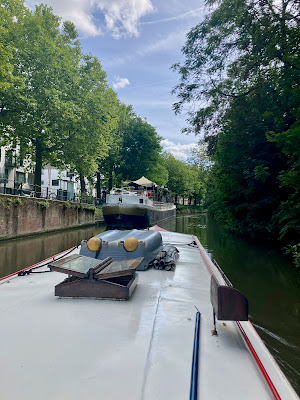 |
| Eventually meeting and entering the Schelde/Scheldt |
 |
| And finally, after passing through the Brusselsepoort lock: our place |
